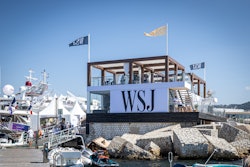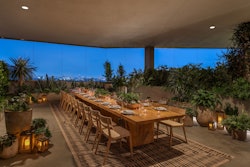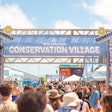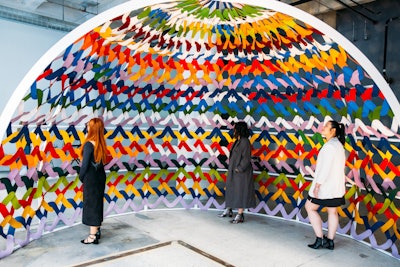
The Wall Street Journal’s Future of Everything Festival, the brand’s largest event of the year, does exactly what its name promises: It showcases innovative ideas around, well, everything—so it’s no surprise that includes sustainability.
“The spirit of the festival is to create a hub of groundbreaking ideas and what we hope is extraordinary storytelling, with newsworthy and candid interviews and hands-on workshops and experiences, all offering a glimpse at the future and the trends that are transforming the way we live and work and play,” explained Helen Bassett, senior vice president of events and experiences for The Wall Street Journal and its parent company, Dow Jones.
As Bassett and the rest of the event team focus on building the festival, they’ve taken a particularly close look at their presence in New York City, the event’s home since its inception in 2018. “While part of our goals are to showcase the innovation that comes with New York, it also comes into play when thinking about sustainability,” said Bassett. “This year, we wanted to look at how we could invest in the future of the city at large, and be a true partner to the New York community.”
While The Wall Street Journal works to incorporate sustainable practices into all its events, which include large-scale conferences, business forums, and much more, the team knew that The Future of Everything Festival, held annually in May, was the right place to take some risks. Bassett and Lindsay Meck, the brand’s executive director of production and digital strategy, recently chatted with BizBash about some of the unique sustainability strategies that were implemented at this year’s event.  The festival's main stage hosted high-profile speakers like former first lady of the United States Michelle Obama (pictured). The stage was later upcycled through a partnership with New York's GreenThumb.Photo: Gary He for The Wall Street Journal
The festival's main stage hosted high-profile speakers like former first lady of the United States Michelle Obama (pictured). The stage was later upcycled through a partnership with New York's GreenThumb.Photo: Gary He for The Wall Street Journal
1. Repurposed sets
Working with their production partners at Studio Left and E2K, the team started considering how the event’s set design could have a second life. “We needed a stage and a backdrop that had our branding, that looked nice on camera, that was conducive to the environment at the venue. But when we were building it for [our event venue] Spring Studios, we were also contemplating where it would go when the event was over,” remembered Meck.
The team ended up reaching out to GreenThumb, the community garden extension of the New York City Parks Department, to ask if they had a use for any of the event materials. While Meck at first assumed they might just want some plants, she quickly learned that elements of the stage design could actually be more useful.
“I think it’s very important when you’re forging new sustainability relationships that you don’t make assumptions [about what they need or want],” she advised. “Ultimately, GreenThumb identified a park, Hart to Hart Community Garden in Brooklyn, and they told us what they really needed was a shade structure—which would allow them to have community meetings and also grow certain plant materials that needed height.”
Meck and her team were then able to go back to the Studio Left team and say, “OK, this needs to work at Spring Studios but also be turned into a secondary thing somewhere else,” she explained. “We were able to create basically a modular LEGO set, a modular trellis that hosted onstage conversations with the likes of Michelle Obama, the mayor of New York, and even Broadway performers. Then, the next day, we disassembled it and our team had a very fun outing where we reassembled it in Brooklyn, where it continues to live. It’s now home to a number of different plants and all sorts of flora and fauna.” 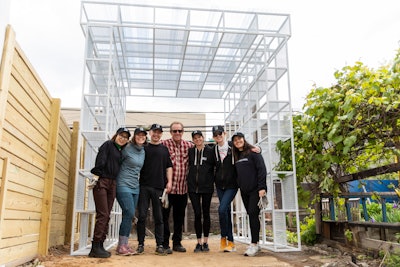 The day after the festival, the WSJ team reassembled the stage to create a shade structure and trellis at Hart to Hart Community Garden in Brooklyn, where it still stands.Photo: Kevin Sikorski for The Wall Street Journal
The day after the festival, the WSJ team reassembled the stage to create a shade structure and trellis at Hart to Hart Community Garden in Brooklyn, where it still stands.Photo: Kevin Sikorski for The Wall Street Journal
2. Sustainable fabrics
The team took a similar approach when choosing fabrics, particularly for the event’s lab space, which showcases future-forward technology. After researching sustainable fabrics, they settled on 100% merino wool. The wool is completely biodegradable, as well as flame-retardant and sound-dampening, noted Meck. It also can be hung, so it doesn’t take up much space in a truck—meaning fewer carbon emissions needed for multiple deliveries.
The merino wool curtains were used to partition the lab, and the materials were later donated to a couple of different places. “We donated half of the material to a community theater in Connecticut, and the rest to a bespoke art project at the LA Design Festival,” said Meck. “The rationale there is we have these materials, we’re going to use them—how can we extend their life in a way that fulfills our goals of sustainability and looking toward the future?” 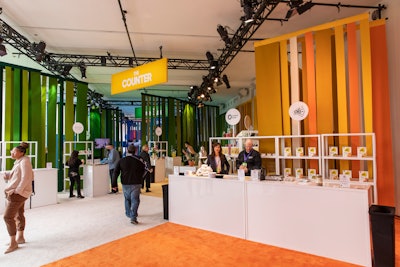 Merino wool curtains were used to partition the lab, and were later donated. (Scroll to the top of this story to see them repurposed for a bespoke art project.)Photo: Kevin Sikorski for The Wall Street Journal
Merino wool curtains were used to partition the lab, and were later donated. (Scroll to the top of this story to see them repurposed for a bespoke art project.)Photo: Kevin Sikorski for The Wall Street Journal
3. Volunteer days for attendees
Inspired by the WSJ team’s own staff volunteer days, the team also incorporated the festival’s very first Giveback Day in 2023. On the third day of the event, attendees could opt into activities at New York’s Hudson River Park or the High Line, where they spent the day working with horticultural teams.
“At Hudson River Park, volunteers weeded garden beds, picked up trash—it may not sound like the most appealing activities, but they were learning about the ecosystem as they were doing that. And at the High Line, our volunteers helped identify plant species using an app called iNaturalist,” explained Meck. “It was all very cool for our attendees; we sold out, so to speak, of those volunteer opportunities very quickly.” 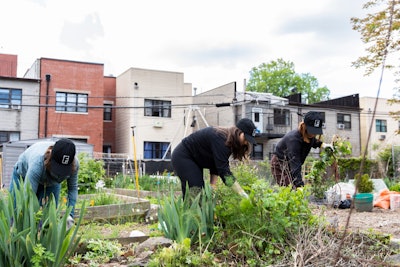 Attendees helped out in local parks during the festival's first Giveback Day.Photo: Kevin Sikorski for The Wall Street Journal
Attendees helped out in local parks during the festival's first Giveback Day.Photo: Kevin Sikorski for The Wall Street Journal
4. Thinking local, and other sustainability strategies
Other than the upcycling and volunteerism, the WSJ team leaned into a number of more traditional sustainability strategies at The Future of Everything Festival, including favoring digital signage and programs, limiting single-use plastics, and working with their caterer to compost and upcycle food. To reduce travel-related carbon emissions and to support the local economy, the team also leaned on local suppliers, furniture vendors, and other businesses when possible.
Inspired by the success of The Future of Everything Festival’s sustainable strategies, the team is also looking at its entire event portfolio holistically. “If we’re building something for one event, can it be a shared resource that’s reskinned and repurposed for another show?” asked Meck. “We are looking at that in regard to some of our centerpieces and on-site florals, for example—can those things be rented, or can they be donated to a local school that could benefit from their second life?”
Bassett and Meck learned a lot from this year’s initiatives and are eager to implement the ideas into next year’s Future of Everything Festival—taking place May 21-23, 2024—and other WSJ events. Their top tips and lessons learned?
Be intentional. For the partnership with GreenThumb, for example, Meck was very conscious of making their donation truly helpful. “We had our own needs for the set, from an audience standpoint, but we also wanted to make sure we weren’t handing over something that didn’t work with the nuances of New York City: It had to be structurally sound; it had to be fine with massive amounts of rain or subzero temperatures,” she explained. “Ultimately, it was important to treat these partners as just as much of a stakeholder as anyone else.”
Ask for help. Don’t think you need to figure this out alone, noted the team. “There are so many organizations doing so many thoughtful things around sustainability,” said Meck. Agency partners, for example, may have a bigger-picture view of what their other clients are doing, so likely have their own ideas. “Lean on the vendors you have and mine them for ideas, and research sustainability-focused partners,” she said, adding that explaining your goals to sponsors is a good idea too. “We got a lot of interest from our festival sponsors on this topic. There’s a lot of interest and ideas there.”
Be practical. “If you want sustainability to be a pillar of your planning, break it down to be as practical as possible,” suggested Bassett. “Don’t try to make it too large of a goal—break it down to be a bit more manageable.”
“There’s sort of an impossibility of being a fully sustainable event,” added Meck. “At some point, it’s still a mass gathering. But we took the approach of, ‘How can we chisel away at this thoughtfully, and use our creative minds cleverly to make a measurable impact?'”





